Gregg Deal is an indigenous artist and a member of the Pyramid Lake Paiute Tribe who has lived in Washington, D.C. for the past 15 years. Deal caught our attention when he live-tweeted the progression of a street mural he was painting to mock the name of the city’s professional football team, the Washington ‘Redskins.’
Team owner Dan Snyder has come under increased pressure and criticism for not changing the team name, despite calls from many Native Americans and advocates to do so. Snyder recently announced plans to launch a foundation to help Native Americans, which some have called an unsuccessful attempt to buy support.
We asked Deal what inspired him to create the mural, his thoughts on Snyder’s foundation, and the role of social media and art in Native American activism.
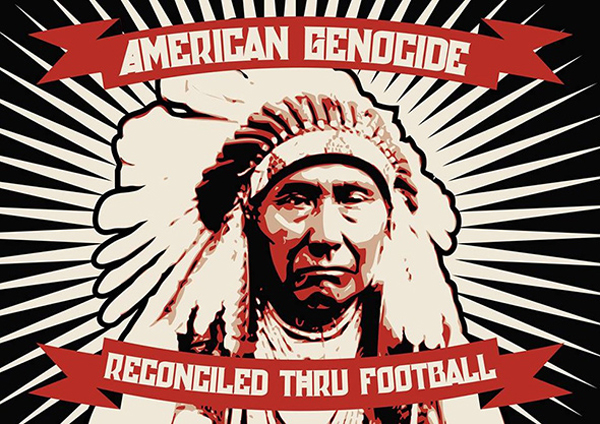
What compelled you to make the mural? What did you want to achieve through it?
My desire was to say something that hasn’t been said, including a perspective not brought to the table. Everyone wants to make this an 80-year issue, but it’s not. It’s a 522-year issue. The issues that are being talked about with the football issue actually span back to 1492. So to put into perspective an American Genocide, something any indigenous person would tell you is a real thing, and juxtaposing that with the ridiculous notion of ‘honor’ or ‘reconciliation’ through racial slurs and gross misrepresentation of indigenous people through caricatures seemed the right thing to do.
Northeast D.C. has residents that are true locals of the city, and who have generations of family that have lived here. Many are fans of the football team. For me to have a piece like that in this area is provocative because of the history of the team in this part of the city. I believe the subject matter of this piece is pretty volatile here. I think it’s even more so in a part of town where many of its fans and local D.C. residents reside.
I’m pushing buttons, using sarcasm, irony and a bit of humor for this work. It can be shocking, but approachable.
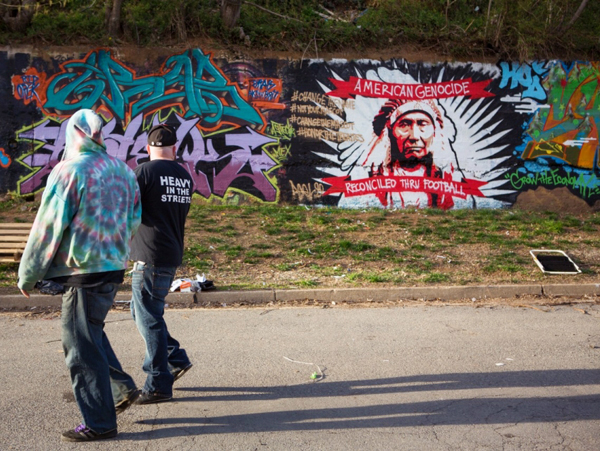
What do you think about Dan Snyder’s Original Americans Foundation?
I think Snyder’s new organization reeks of desperation. His gifts, while helpful in the short term, are about as meaningful as giving presidential medals to starving Indian chiefs in the 1800s or rotting meat to starving Natives during the reservation era. He cares about indigenous people only so far as he can buy them off. We are as important to him as the ants on the sidewalk leading up to FedEx Field. [Snyder’s foundation is] about as meaningful as giving presidential medals to starving Indian chiefs in the 1800s or rotting meat to starving Natives during the reservation era.
You included popular Twitter hashtags such as #ChangeTheName and #NotYourMascot in your mural – how has social media influenced the discourse on the Washington team name controversy?
I have been participating in the various Twitter storms going on using those hashtags. When I created the video #changethename it was to coincide with that. I think social media for civil rights and social change is important because it gives voice to those who might not otherwise have it.
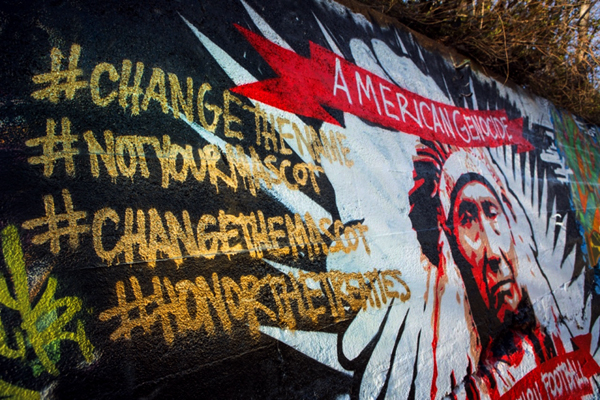
Mainstream media has often skipped over indigenous issues and causes, and now it is at the point where it’s becoming more difficult to ignore us with issues like fracking, drilling, the Keystone XL pipeline, Indian Child Welfare Act, substance abuse, health problems and even the mascot issue. With my work, if I can create something, free-sourced, that speaks to the people involved, or the issue at hand, I am honored to give it away. Visual art can serve as an important illustration to any issue. I think social media for civil rights and social change is important because it gives voice to those who might not otherwise have it.
Could you explain your choice of Chief Joseph for the portrait and the words you chose?
Chief Joseph is an interesting character. He fought when he needed to fight, but when he realized warfare needed to come from a different angle, he didn’t hesitate to take that stance. He was a proponent of peace, and supported people making change by using their words, and any other peaceful means to accomplish equality, and even reconciliation of lost land, lives, culture and tradition.
What role do you think graffiti art plays in activism, and which artists have influenced you?
The beauty of graffiti and street art is the way it cuts out institutions that use elitism to separate the people from the beauty of art. From the beginning graffiti and street art was art for the masses, using our streets as gallery walls. I did a lot of graffiti in the 90s out west, and have used street art to express these types of issues and beyond. The influence that comes into play is the freedom associated with putting your stuff out there. The beauty is how it becomes perpetuated through social media, and the temporary nature of street art and graffiti lives on.
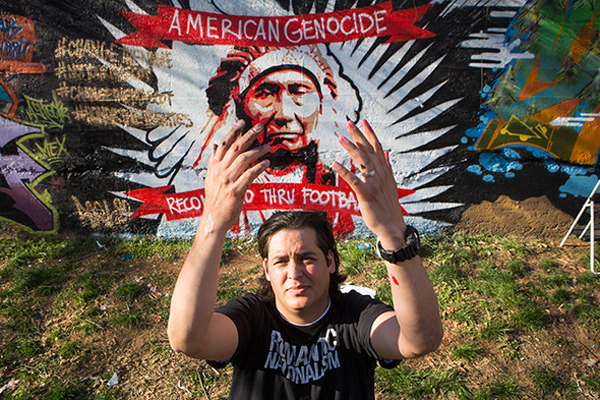
But this type of art in activism is vastly important to me because it allows me to have a voice that is different from someone talking about it on CNN or even speaking at a street rally. My art gives me my authority. My work on the street doesn’t have a curator saying it’s not good enough, or it’s too edgy, or not relevant. The voice is my own. The beauty of graffiti and street art is the way it cuts out institutions that use elitism to separate the people from the beauty of art.
I am influence by a number of local guys like 181HKS, Ultra, Con, Maz Paz, to name just a few. Nationally, I have always been a huge fan (even in my younger years) of GIANT, REVOK, TWIST and of course the graphic stylings of Shepard Fairey. But in all honesty, the ones that are really inspiring me right now are the group of artists in my crew Honor The Treaties. A group of Indigenous artists that are insanely talented. Jaque Fraqua, Ernesto Yerena, Nani Chacon, Tom Greyeyes, Cheyenne Randall and Jared Yazzie.
What other similar art projects have you done?
I recently conceptualized and created a performance piece called “Traditional Washington Redskins Honor Ceremony” in which I put a white man on display wearing a team jersey and hat.
He was drinking beer, eating chips and watching a football game all the while cheering on the team. This piece was part of an opening to a solo show in D.C. and was meant to flip the fetishizing and objectification of indigenous people over to the fans. It was also a great illustration to how incredibly ridiculous the argument of ‘honor’ is in this situation. I can’t imagine any team that cheers for a touchdown and starts singing “Hail To the Redskins” is thinking about the systematic genocide of indigenous people, or the Native woman who froze to death last winter because she had no heat in her house on the reservation. Honor deserves respect.
I have also been doing The Last American Indian On Earth, a performance art piece in which I take the stereotype and place it into modern everyday moments. This puts me in the grocery store, shopping mall, or even sight-seeing in D.C. or New York City. The whole purpose is to confront the public with this nostalgic relic as a living breathing thing. What often comes out is horrible stereotypes, racial epitaphs and whatever offensive thing you can imaging, thus illustrating the inept relationship and understanding America has with its first peoples. I am in the midst of documenting this performance piece for a film.
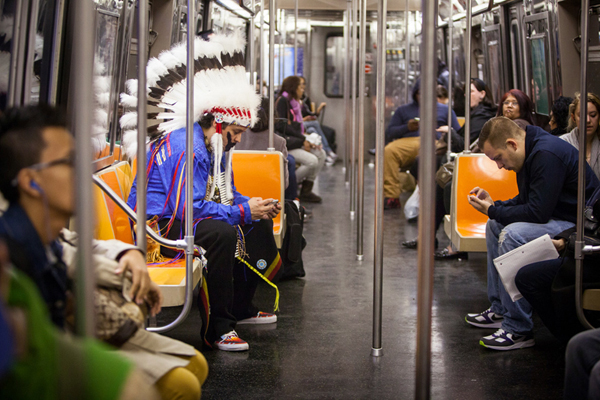
See a gallery of The Last American Indian on Earth here.






